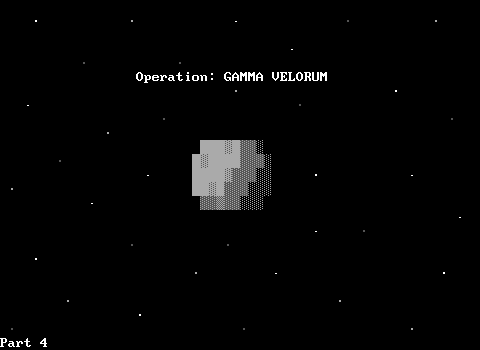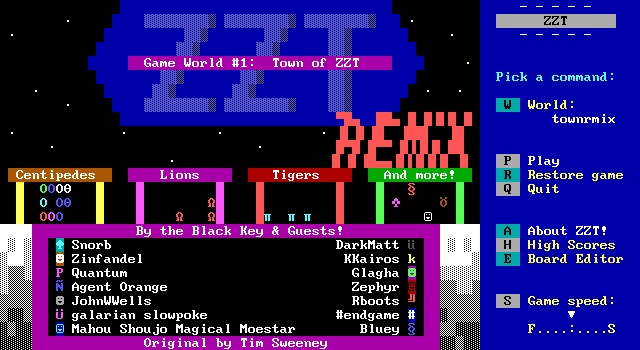
It's been one collaboration after another lately. After a neck and neck poll for this month's Closer Look article, Town of ZZT Remix just barely pulled ahead against Pepper Bolette Special Edition at the last moment. Its victory brings us to four group projects in a row after a five-man flub in Death Gate, a friendly duo with King's Quest ZZT, and then another split effort with rough spots in Space Fighter: Mercenary.
Town of ZZT Remix, has the distinction of being the largest collaborative work in ZZT's history in which the combined efforts make one fully interwoven work. There are fourteen cooks in this kitchen, something that historically would be a recipe for disaster, but the ZZT community is today far older and far wiser with regards to collaboration. The Remix project began in 2020 after the success of seven authors' efforts with Small Spaces, Town of ZZT Remix looked to re-imagine ZZT's first world Town of ZZT, and put a modern spin on it, one board at a time. While there was never a hard deadline for when the game should be released, as the months passed and January 2021 drew nearer it became clear how fitting it would be to get the game out in time for ZZT"s 30th anniversary. This kick in the pants worked great and led to a revitalization of efforts in a game that was otherwise being slowly assembled.
Remix ends up with the distinction of being ZZT's first game of 2021, and as a 30th anniversary celebration, you couldn't ask for anything more. So many people stepped up to contribute to this project to celebrate not just Town, but the impact that ZZT has had on so many people across all these years. Authors were allowed to reserve one board at a time, and only when a previous was completed could they adopt another. A few names got a pretty sizable number, but even when somebody had just one submission, that's often plenty of material available to understand what they had to offer the project.
When you play Remix, the different authors often lend their style to their boards in such a way that you might be able to figure out who was responsible for what. While each board has its subtle hints in terms of writing style, visuals, or just what they saw fit to adapt from the original or what to discard, the game feels properly mixed together. This isn't like Death Gate where each author's contributions have no bearing on any others. Remix includes little bits of progress to track, and little bits of feedback based on what actions the player has taken resulting in the seams being a lot harder to notice.
If you haven't actually played this one, I'd strongly recommend doing so right away. Even if it will take longer than Town to complete, getting to experience all these unique re-imaginings with unspoiled eyes is worth the time to see it all. If you haven't played Town, well, probably play that one first too. You can't appreciate the changes if you can't recognize them after all.
The usual structure for these articles is to pick aspects to focus on or just running through the game in the order that I experienced it. Like Town, remix remains open to pursue in any order, but what I really want to focus on this time is each author's contributions, and as such we'll be looking at this on a board-by-board basis for each contributor. With all the experience these authors have had over the years, there's not need to worry about a lack of health, ammo, or other resources. Puzzles can be reset, and avoiding soft-locks is a top priority. The polish and care is readily apparent from the very beginning.
As it turns out, Remix is pretty huge when studied this way, and as such we're looking at a two-parter. This first part will focus on the authors with a small number of contributions, and part two will conclude with the heavy lifters of the project who really went the extra mile to see to it that Remix became a finished project. (Or something roughly along those lines.)
Quantum P.'s Board
Room One - 2021 (with collaboration from: Agent Orange, Snorb, and Galarian Slowpoke)
Original: Room 1
It'd be difficult to start anywhere else. What surprised me the most about Quantum's only credit board is that it's also one of a handful of boards with multiple collaborators. I'm surprised he didn't get even a single board to be his own and no one else's, but if there's going to be a board with collaboration, this is definitely the one that needs it most. File this under Quantum because otherwise poor Quantum wouldn't get a heading.
As the player's introduction to Remix this board has the responsibility of setting the player's expectations. Going in, the player will be unsure whether this is going to be a bit of a touch-up to ZZT's first world, or a radical overhaul that puts its own original vision ahead of what Tim Sweeney was tinkering with thirty years ago. Perhaps unsurprisingly, this opening board fits in between both extremes. Anybody familiar with Town will immediately be able to recognize everything that's been changed on this board immediately.
One type of change that's quite common and welcome is better accessibility. I am a crusader against ZZT's default doors with white foregrounds and ever-shrinking pixels of similar looking dark colors on higher-resolution screens (and my ever lowering in fidelity eyeballs), so seeing the very clear purple-on-dark-purple door is a welcome change. Not everybody in Remix does this specific combination of bright-on-dark, but at least there won't be any headaches over reds and yellows or greens and cyans on screens where multiple key colors exist.
Gone is the Epic MegaGames copyright. We're MIT licensed now baby. In its place there's now a brand new café with outdoor dining. This immediately remedies one of the biggest issues with Town: its lack of ways to restore health. Town offers nothing in this regard. The only way to increase health is to collect gems, giving the player a surprisingly finite amount of hits they can take, a number in the low-20s. Now gems are given more purpose with the addition of being able to order off a menu of salads, sandwiches, and espresso.
The world doesn't make it clear who did what here, but the café is surprisingly robust. Over the past 30 years quite a lot of tricks with ZZT-OOP have been found, and the café is a great example of how fancy code can sometimes be employed for simple purposes. Tricks to detect when the player enters a board combined with objects hiding in the walls allow for the tables to randomly have other customers come and go. This tiny detail alone makes the remixed town feel more like a place with people living in it than anything in the original. Of course, it's still a town full of slider puzzles, dragon-filled castles, mazes filled with giant centipedes, and all kinds of other things that probably keep the property values low.

Less impressive, but still clever is that the items available for order will restore a random amount of health determined at the start of the game. An odd choice actually when you're so used to having to stop and consider your purchasing power, but I suppose sometimes the egg salad isn't as good you'd hope. This is a neat change as it gives the player the usual opportunity to learn what item is the best for the price, but by randomizing those values once, (through some clever zapping,) there's no correct answer to know in advance for a later playthrough.
Meanwhile, the armory has received a radical new paint job, really the entire board has. Most, though not all boards in Remix are happy to adopt the enhanced color palette offered by modern editors. While the original colors are gone, the replacements remain just as vivid, showing an appreciation for the simple abstract coloring of the original rather than discarding it for buildings of dark red brick and gray steel.
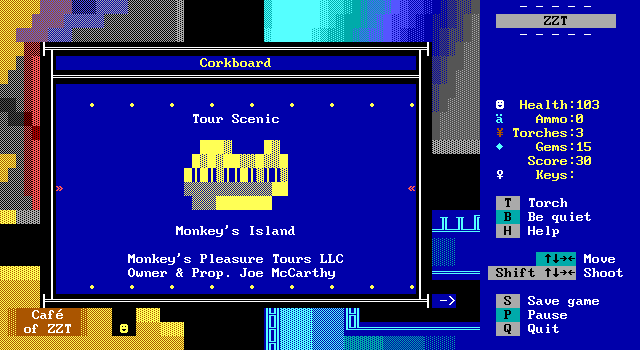
The bank has the biggest overhaul of all, no longer being a building with a dark interior and mechanical vault. Though that component will still remain on its own board, here it's probably the star of the show with the sort of things you'd expect to find in a bank. There's an ATM, racks with various fliers, an armed guard waiting for somebody to try something stupid, and various forms for making deposits or withdrawals. No tellers though. Must be a Sunday.
It's also full of references to other ZZT worlds created over the years. A cork-board can be inspected multiple times revealing a microwave oven for sale, a missing persons report for Karen, the Black wizard, a hiring fast food restaurant with a dubious workplace safety record, and a few others. It's a cute way to celebrate not just 30 years of Town, but all the unique worlds that ZZTers have given us.
The general layout still needs to be maintained as the board exits are the same from old to new. This places the Palace in an precarious spot. The original never really felt all the "palacey" to me. Here the creative use of simple linewalls helps make it more fitting with its parapets poking up across the top row of the structure.
Smack in the center of the crossroads remains the introductory sign from the original, kept almost identical. Your quest in unchanged. Find the five purple keys, enter the palace, and see what happens! Just as in the original, the player is overwhelmed with options, four ways to walk past the edge of the board, two passages into the armory and bank, and then another tantalizing exit beyond the first purple door of the palace.
Zephyr's Boards
Bug Maze a.k.a. "Don't Squash the Bugs!"
Original: Bug Maze a.k.a. "Ecch! Bugs! Look out!"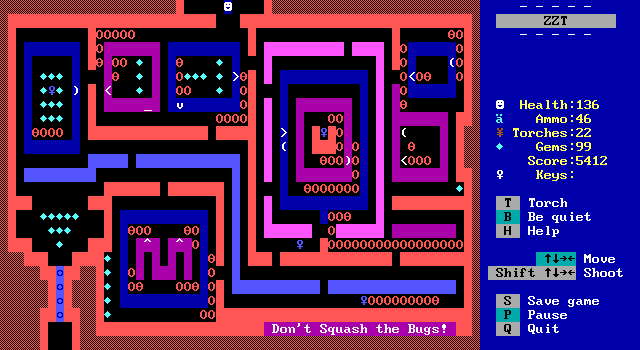
As a child I would always go south first as the original board offers a whole bunch of ammo that's free for the taking. No such luck here. Zephyr turns an action board into a puzzle, but does so in a way that's not immediately apparent. Your first thought upon entering here are that this is a simple change to the original layout. You still need to get numerous keys and bring them to the doors to reach the exit, watching out for giant centipedes as you do so. In the original, dealing with the centipedes meant timing your shots (only one bullet could be fired at a time) and making sure another centipede didn't sneak up behind the player while doing so. This board could very much have been just that, but the remixing here turns an old foe into a new friend.
While various animals are still incredibly common enemies in games to this day, there's a lot more interest in petting them, and not pre-emptively going on the attack regardless of what danger they may present. Centipede has a good ten years on ZZT, so they're maybe a bit overdue for getting some love.
This time the player is outright denied the ability to shoot even if the centipedes may still bite. Instead, the player player gets an etude on transporters, having to use them to block spaces adjacent to transporters in order to temporarily reroute them. It's actually really clever! The pace is noticeably slower than the original as you'll often have to wait for a centipede to get into the right position. Even so, if anything the danger is magnified as its all too easy to be focusing so much on the movement of the centipede you need to obstruct a transporter that you don't notice another centipede has sneaked up on the player.
The "Don't Squash the Bugs!" message is a subtle hint, not only that the player's squashing is going to come at the expense of their own health, but the shorter each 'pede gets, the more difficult it becomes to time transporter usage. This is a great board that takes the original concept in an entirely new direction, while still maintaining its familiarity.
Labrynth 1
Original: Labrynth 1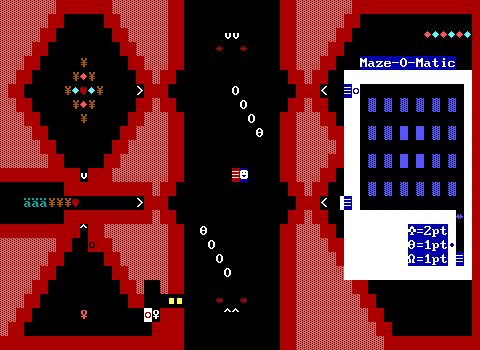
Zephyr is our first author to take on multiple boards. Board number two here is what's normally a forgettable one: the first board of the castle labyrinth. This is a dark room, so the giant "Maze-O-Matic" on the right half of the screen is a surprise until it becomes relevant. Still, right from the start the board differentiates itself from the source. A normally safe empty hallway has been given a brand new centipede patrol. This time the player is welcome to squash the bugs, and they'll likely want to do so as these centipedes have been primed to move diagonally, something ZZT doesn't permit without some more advanced tweaking of properties in external editors. Diagonal creatures are so disorienting to fight and cover ground significantly faster, moving in one tick what would normally take two which makes them a lot more dangerous to leave running around than their right-angled brethren.
The player is given some help in navigating the darkness of this main hall with the addition of some transporters and sliders. If the player is willing to take the time to obstruct the transporters they'll be rewarded with two-way fast travel across the board. The danger of the centipedes isn't all that much to warrant this, however this is the start of a dark maze consisting of several boards. Not only does it respect the player's time by not making them cross an emptied hall every time as they wander around, but it also helps save on torches.
When the maze is finished, the player returns to this board from the west side, getting some items including a few health restoring heart objects that are new to Remix (though they are based on the hearts from the Twisty Cave board in Caves of ZZT).
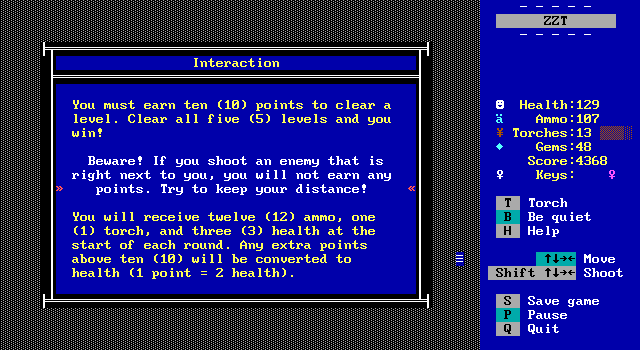
All of this is ignoring the elephant in the room that is the Maze-O-Matic machine! If I had to guess the author for this board I'd have bet on KKairos whose work with procedural generation in ZZT over the years has been pretty substantial. Zephyr is here to take a crack at it with this maze in a maze mini-game. Upon entering the strange device, the player's score is carefully stored using objects that try to take powers-of-two points away and placing walls if they could, thereby encoding the original value in binary. From there they're treated to a randomly generated, yet always solvable maze that gets populated with lions, centipede heads, and ruffians. The goal is to score 10 points in the maze, grab the key, and open the exit. Doing so results in some supplies being handed out, and if the score requirement has been met the level increments as well. It's short and simple, and if you were really desperate you can cheese it to farm supplies (there is no reason to do this in Remix). Admittedly, this change is a bit radical for me. It's a very odd item to just drop in the middle of a board like this. Still, I can't argue the fact that it's most definitely a step up compared to the original board's handful of ruffians. As unconventional as Zephyr's Maze-O-Matic may be, turning this board into something the player will actually remember the next day is definitely commendable.
Glagha's Boards
Forest 1
Original: Forest 1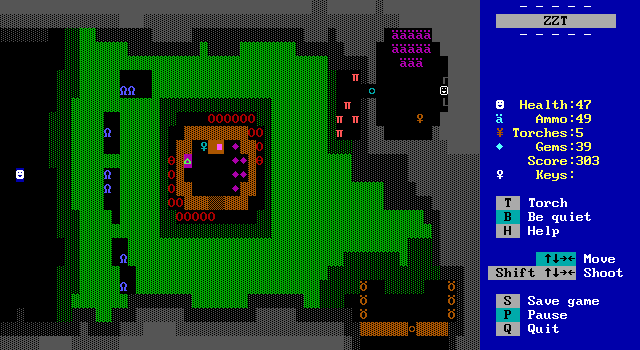
The eastern path is notable for just how similar to the originals all the boards all. This one could very well have been out of a Town of ZZT: STK Edition from the mid-90s with its gray walls and unusual enemy colors. Luckily, there is more to it than a fresh coat of dark colored paint. Gone are the weird assortment of pushers in the original. These seem like they're meant to pin the player into an area, though it's trivial to just carve away more forest as even if it widens the paths a little, the room is big and open enough that you're not going to regret it.
Glagha does away with the extraneous pushers, instead positioning small pockets of lions in such a way that the player can't avoid a fight. The action is definitely more refined here, replacing the scattered energizers with just one in the middle, requiring more thought as to how to best use it. The tigers seem an obvious choice, but those bears will definitely position themselves in your way once you head to that yellow (brown) key up top.
The uh, room in the middle of the board is a bit more defined, and feels more like a small closed-off dwelling rather than some squiggly lines in the original. It also adds a bit of flavor to the board with an old journal discussing how its owner was never able to find the treasure of the forest: the Zirconium Zanzibarian Torc.
This could send the player on a tile-hunt to find the torc, and you can very much do so if you really want. Realistically, you're not going to want to spend that kind of time. Again Glagha delivers though, providing more hints to players that show a little respect to the dead.
The top right corner is now locked up by the key in the building, rather than having a spot in the corner with a key to open said building-thing. Inside are some essential resources should this be the first path the player heads down, the key to the rest of the forest, and a chained up skeleton forever pinned to the wall.
The original ZZT worlds are no strangers to skeletons, but throwing one into Town implies there's got to be some sort of reasoning to the addition. The player is rewarded for examining the skeleton a few times with the skeleton giving a friendly hello after a certain point. It seems like a silly little inclusion similar to the surprise talking tree of Town, but if you're really thinking, it might occur to you to try breaking the chains that bond them.
Glagha then has the skeleton offer the player one wish to be granted. Ammo, gems, or a hug are all on the table. Apparently a lover of secrets, Glagha isn't done hiding things yet, doing the old fake scroll footer trick to hide a fourth option to wish for "a secret". If the player selects this, then the skeleton will reveal the location of the torc that they were never able to find in life, offing some nice closure to the mystery of whose journal you found and why Remix has a skeleton now. All of this is for bonus points (or health/ammo if you wish for those items), so it's no big deal to miss in terms of gameplay. That being said, if you don't putting the pieces together with discovering the skeleton can speak and be rescued it makes for a rather strange board. The torc is in a fixed position, so if you know about it already, or happen to luck your way into finding it, the other rewards can still make freeing the skeleton beneficial beyond being a good Samaritan.
Mutant Bear Labyrinth
Original: Lab 3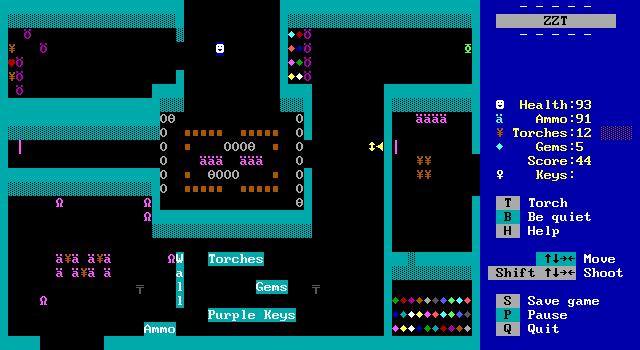
The next board is another one of the many typically forgettable dark rooms of the castle labyrinth. The "mutant bear" theme found in the title isn't ever stated in game, leading the various recolored enemies not really being interpreted as anything more than palette swaps. This is one instance where I do miss the original board's row of spinning guns. It's a dangerous path to cross, but cautious players who look for alternate routes are rewarded by avoiding them entirely. Those are gone now, and in their place is the castle storage. Brown boxes create a small arena to fight some centipedes in with the option to crush them with boulders if you're willing to make the movement of the remaining pedes a little more chaotic as the previously orthogonal shape gets broken.
Like Glagha's previous board in the forest, this one also enjoys playing with the concept of secrets. Here getting to a large cache of gems is a bit more obvious with an out-of-place wall being fake.
Being part of an open-ended maze, this one can play out a bit differently based on how the player first ventures onto the board. Entering from the north gives them time to get their bearings as the bears will slowly march over and the centipedes will happily do laps around their room. Coming in from the south is more dangerous with a few of the lions starting rather close to the player's starting point. Lastly, coming from the east begins with the player in total safety, but at the mercy of a transporter whose destination in the dark is entirely unknown.
Glagha isn't cruel, and while it's a big leap that could definitely be disorienting, there's no immediate trouble aside from the journey being one-way. Luckily a pusher can be set off to link the transporters from the other side. The centipedes are really not a fan of this, almost certainly being crushed and split into pieces as the merciless pusher pushes perpetually.
The "storage" vibe is well communicated with some humor included as well. The spare sign storage in itself is a joking commentary on the over-labeling seen throughout Town and other early ZZT worlds, something that acquired a bad reputation as years went on. Today excessive labeling is more tongue-in-cheek, and viewed more as a throwback to long past carefree days, so you still won't see it come up much unless something is deliberately playing on having the vibes of an early ZZT world.
One of the roughest things about these labyrinth boards however, is how easy they are to miss! I completely missed this board and had to go back later to see how it actually feels to play. The spare signs bring the room to life more than the original, but this one is less of an iconic moment and more of a traditional ZZT action board that's trying to stand out amongst countless others with some silly jokes, secret passages, and the unique transporter path that plays out quite differently depending on where the player entered the board.
Zinfandel's Boards
Armory
Original: Armory
For boards in Town you'd expect to be highly coveted for remixing, the armory has to be very high on the list. The armory offers ZZT's first store, what for many would be their first puzzle, and the immediate realization that ZZT games are weird thanks to Tim pioneering the tradition of including song lyrics. The inclusion of references to a favorite band became a tradition that would continue for decades as teenagers rushed to tell the world about Marilyn Manson, Tool, Billy Joel, and countless more. Not to mention the guardian of the key, introducing countless children to the word "cretin". It's one of the most memorable boards in the original, and one of the only ones that isn't actively trying to kill the player. In fact, it's the only place those gems can be of use after picking them up giving them an opportunity to leave in a better state than they entered.
Zinfandel distills the armory down into its two biggest components and pits the occupants against each other. Town has some odd pricing with a single gem buying either three ammo or a single torch. (Or you can just read some Stairway lyrics. (I don't need to link this one right??)). Zinfandel turns the pricing into a gameplay mechanic, and transforms the stockroom from an unrelated building to the rightful supply of the vendor. Now the prices are significantly worse! The same items cost a whopping five gems rather than one, with a new option to complain about the prices. Turns out the guardian came across the storeroom key and is now keeping it for himself. In the meantime, prices are high until the key can be recovered or a locksmith can be afforded.
This is quite the overhaul! Until the player can get the key back it is deliberately not worthwhile to make a purchase here. The good news is that ammo can be purchased elsewhere at a more reasonable price of ten ammo for five gems. Of course, you have to find that location, and depending on what order you happen to explore the town, it might be quite awhile before you're aware of it. The better news is that Remix is more than fair about the ammo and torches provided. Like in Town the shop is only ever actually needed by the truly desperate.
As in Town you could simply get the key from the guardian whenever you like. The original guardian of key is a wonderful little tutorial to object behavior in ZZT. Ring the doorbell, and the guardian's walk to yell at the player is fully scripted. Get your timing right and they'll obliviously push the key right out the door giving the player access to a great set of supplies to start the game with. In Zinfandel's remixed version, the puzzle shifts from nailing the timing to a selection of trivia questions.
I've never been big on trivia in ZZT worlds. It never feels appropriate to ask the player about outside knowledge, and while asking about the game is at least information the player has access to, it still suffers from often being rather obtuse questions. Zinfandel does thankfully opt for trivia about the Remix, and uses a particularly generous system in terms of what knowledge is required and what the consequences for incorrect answers are.
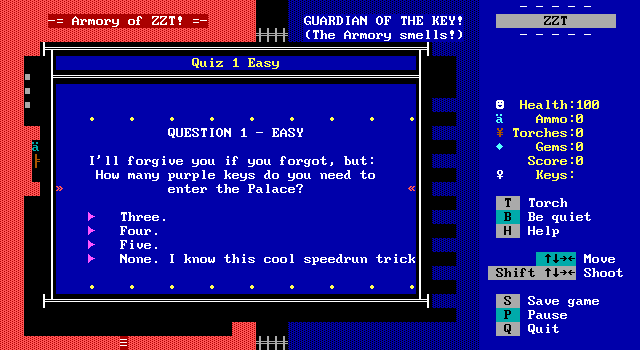
Upon ringing this guardian's doorbell you're instructed to proceed though the many doors to the key with the choice of easy or hard trivia. It's all multiple choice, and the penalty for a wrong answer is a very amusing forced ejection from the building that tosses the player into a trash pile outside. While a lot of the easy trivia is either found on the starting board or even the sidebar, (one question asks what key to press to save your game,) a few questions contain information that will only be found on the eastern path. One question, which thinking about it, really shouldn't be under the easy category, requires identifying what other ZZT game wasn't referenced in the bank. In recent years there's been a lot of care put into games to try and make sure that you didn't have to be playing ZZT twenty years ago to be able to understand what's happening, so I feel as if this one outlier that expects the player to know about ZZT games released from 1994 through 1999 is a small flub.
The complaint is pretty easily neutralized, as even a blind guess has a one in four chance of being correct. The only penalty for being wrong is having to walk up to question object again, and you can just save before making a guess regardless. Nobody's day is going to be ruined here.
The hard trivia is definitely more reliant on exploring the world, requiring knowledge from every direction but west of the starting board, and making note of some otherwise minor details. If you're trying to answer these questions without any guessing, it can be quite some time before you can get your key, forcing you to rely on sketchier shops for your goods. Again, you don't need to shop here or there, and can very easily get through Remix without spending a gem on supplies.
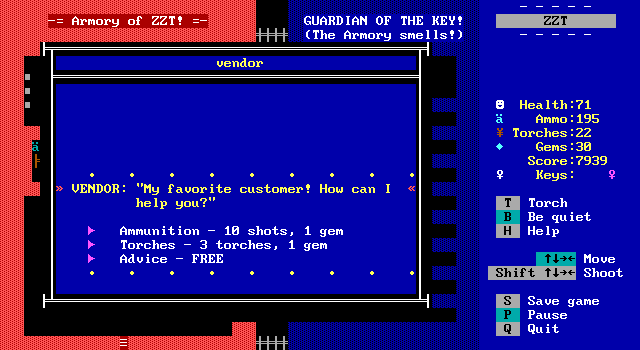
Once the key has been recovered, the pricing skews significantly in the player's favor. It's all moot by how far along you'll be if you're only answering questions when you know the answer regardless of the available options, though that's hardly Zinfandel's fault. Even with fair pricing out of the gate, the player won't ever need to do any shopping here. It remains just an in case of emergency kind of deal. Transforming something borderline vestigial into a world-spanning sidequest at least ensures that the player will be paying attention to the game!
One other change here however is that getting the key is no longer optional. The benefits of the armory pricing are, but there's still a suspicious column of boulders in the locked backroom that a certain bandit will be telling us about later...
Oh, and don't fret. While this vendor can provide some actual relevant advice, they can also provide some lyrics from The Immigrant Song as well.
Lab 5 - InvisoMaze a.k.a. "The Room of X-TREME Annoyance"
Original: Lab 5 - InvisoMaze a.k.a. "The Room of Extreme Annoyance"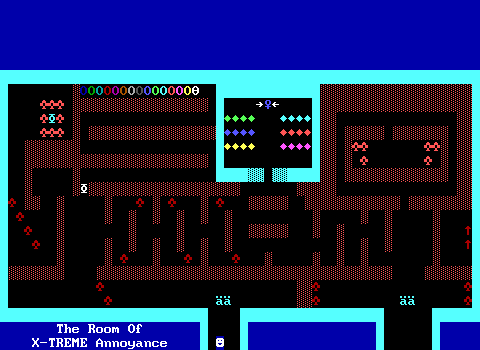
A constant throughout ZZT's history is using the simple mechanics of ZZT to make something far more complex than anything Sweeney ever imagined the engine would be capable of. In this case, Tim tried making a board that was deliberately annoying, and over the years so many people have done so so so very very very much much much worse. This original board seems so quaint now. It's an invisible maze with wide passages and long corridors that make it easy to move around even if you might overshoot your next turn. The board is designed to require entering the board from both halves, one to get a key, and the other to reach its door. A few centipedes roam around, vaguely hinting at walkable space, though hardly offering an actual challenge to the player.
It would be quite easy to make a miserable version of this sort of thing. I could rattle off awful boards in this vein all day long. Zinfandel's second board is thankfully happy to avoid the countless ways you can make a maze in ZZT miserable, while still including a few new touches that allow the board to maintain its "annoying" status.
First, what the board does to be nice to the player. While there are still two entrances to the maze, both sides meet up in the center so you can get everything in one trip. Second, the traditional technique to make invisible mazes more tolerable is employed. Upon bumping into any wall, rather than just have that tile be revealed, the entire maze flashes allowing the player to get an idea of how they need to move. Third, it's actually a slightly smaller board overall.
While hardly a positive, there are a lot more enemies to deal with. Much of what makes these kinds of mazes so unpleasant is the lack of engagement from the player. When all you're doing is touching wall after wall, having enemies to fight gives you something to do, and creates a threat other than wasting away precious minutes of your life. I'd much rather all these ruffians be here than not.
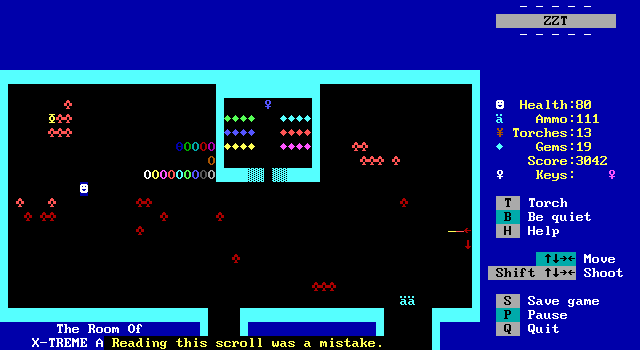
Zinfandel does a great job here creating annoyances that aren't so bad in the grand scheme of things. It's the kind of annoyances you'll find yourself laughing at. A scroll surrounded by reveals itself to have just been a waste of your time and probably health, but in good humor allows its extra-long length to be used as a makeshift bandage to heal your fresh wounds. The other scroll simply states that you shouldn't have touched it, a sensible message given that its presence locks a giant centipede set to move at cycle one penned in place. Free them at your own risk.
In one case, eliciting a response fear to something is better than actually going through with it. A pair of spinning guns on the right aggressively throw stars when the player is near, getting you to brace yourself for something miserable. Once the walls are revealed, it becomes clear that the guns are just a trick and their projectiles can't actually reach the playable area of the board.
Lastly, and best of all is the removal of the yellow key to collect. This is a great gag where upon trying to enter the chamber with the blue key you need you'll suddenly find yourself "blocked by an invisible door" that reveals itself (and the invisible key) upon being touched. Zinfandel is even nice enough to make it work in reverse. In the unlikely event you happen to step on the tile where the key is, you'll get a message about being blocked by an invisible key before it and the door reveal themselves.
This is absolutely how you strike a balance between the old and the new. The room of X-TREME annoyance will fluster you, but it won't frustrate. It takes a slow moment from the original game, and turns it into something that will have you laughing to yourself as you venture through it.
KKairos's Boards
Four Lakes
Original: Waterboard a.k.a. "The Three Lakes"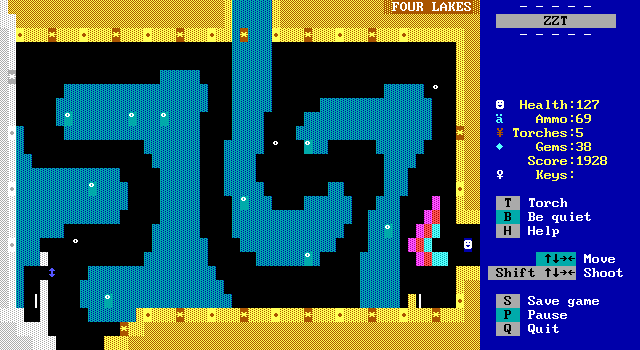
I'm quite a fan of this first of three remixed boards handled by KKairos! This board lets me relive my youth as a less-coordinated child attempting to conquer the Three Lakes by running through it while screaming the entire time!
At first, this seems like a natural evolution of the concept of the three lakes, rather than some very stiff waterways, the path now flows like water requiring a far more tricky path to navigate. If you actually take a look at the original board with visible empties, you can see that a looser design appears to have been considered at one point. This time, the bullets don't just come from the far wall. They're instead shot from the various round points lining the room. What makes this board so scary isn't merely the attack from all directions, but the attack coming from diagonals. By modifying the X-Step and Y-Step values of an object (essentially making them walk diagonally into the walls), they are then free to fire diagonal bullets with #shoot opp flow. The firing patterns are randomized, and rather than hit walls, these bullets will run into ricochets causing them to be deflected back from whence they came.
This is already difficult enough with how rare diagonals are seen in ZZT, and it's made even more challenging by the optical illusions the diagonal movement produces. You might not think it would matter all that much, but the tiny circle that makes up the degree sign character being closer to the top of the character than the middle makes it all the more challenging to parse where it's located and where it's going. It's very easy to trick yourself into thinking you're standing somewhere safe when in reality that next bullet is closer than you think!
I really couldn't find a good strategy here. As with the original, you're unable to shoot and being hit sends you back to the start of the board. The best I could come up with was to try and hug the walls when possible and it's much easier to tell when you're in a bullet's path when you're running close to the source of those bullets or a ricochet. That can be helpful for some portions of the board, but when you're running vertically it was nothing for me but hope and perhaps giving in and making saves in the middle of the board to restart from instead.
Only a handful of boards in Remix really crank up the difficulty compared to the original, and it's definitely the western path that's the biggest challenge. The only thing KKairos is willing to cede to the player here is a pair of transporters which prevent the player from having to run the same course backwards on their way back to the hub.
Crank Fault
Original: Bank Vault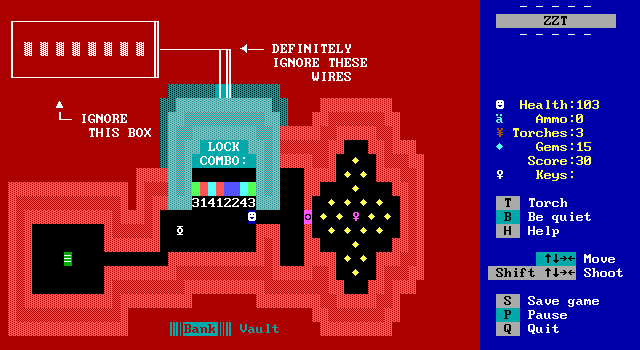
The four lakes marked an increase in screaming over the original, yes, but it's all balanced out by this much friendlier bank vault. Poor Tim made this neat little mechanic locking system to allow you to input a combination, and then had to shut the lights off so its solution wouldn't reveal itself. KKairos is hardly one to shy away from some coding, and opts for a far more stylized system that lets the lights stay on. In addition to turning a dark and dreary vault into a far more welcoming excursion, the real benefit here of going with code over sliders is that you can input the wrong combination as many times as you like. Meanwhile in Town you can start a game, run to the bank, see some text that says "PUSH", push a boulder and soft-lock the game in less than 10 seconds. You might not even realize it, as the essential purple key is hidden in the dark, playing through the rest of the game as normal, and thinking you're just missing out on some bonus points. No, this alternative is a vast improvement despite losing the novelty of using sliders and boulders to make a lock without any code.
Also welcome is some new backstory that paints the player's actions in a more positive light. Listen, this is still the protagonist of Town and there's going to be a jailbreak, and quite a lot of shooting on this adventure, but bank robbery will no longer be added to the dossier. Now, a wealthy woman of unknown origin has left an inheritance to whoever can figure out the combination. The combination is entered by touching objects to cycle their value from one through four which coincidentally changes the color of the wall above them. Once a combination has been set, touching the vault door will begin a number crunching operations to check the combination against the coded solution. Answer correctly, and the key and gems within the vault are yours. Answer incorrectly, and some hidden security system will turn on the player, firing a few bullets in a way that can be dodged if you manage to be quick/get lucky, or likely just taking a loss of ten health (unless you're really foolish and run into more afterwards).
This is a board whose original form was perhaps one of the first mysteries for ZZTers wondering how it worked. Without access to cheats to turn on the lights, or knowledge of using ?+DEBUG to bypass Town's lock on editing, understanding how the vault worked was an indication that you knew your ZZTs. (At least until other worlds made it public knowledge.) Ironically, to experienced ZZTers today, this password system's internals are blatantly obvious, and to create it without using any code like Sweeney did in the first place is what seems more impressive.
But then you couldn't be wrong and the room would be a dark boring mess. This style is by far the way to go. Remix is here to celebrate Town and revisit its concepts, and is hardly the place to expect a coder to show off what they've come up with. The new method is faster, fun to watch, and allows the player to make mistakes, all major positives in my book.
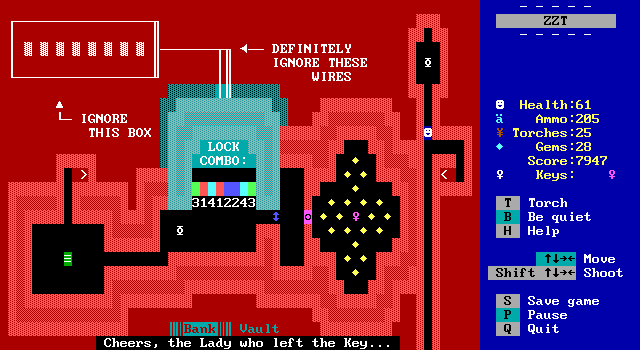
As you'll see on KKairos's next board, he was also in charge of the board that previously revealed the bank combination, and made a rather clever adjustment. You won't actually receive the combination on that board, but instead there's a new path that actually connects back to the bank board, revealing a hidden path that's normally obscured in red, and allowing the player to go from getting the combination to entering it just a moment later. Town already had a precedent for some unexpected board connections, with the armory linking to the House of Blues, and the Rube Board connecting to a deeper part of the eastern cave. Putting this new connection in not only fits in with what's been done before, but makes perfect sense to add.
Hold up, only with this article 99% finished do I realize that there's another reason the combination is on this board. By utilizing randomness similar to the café, KKairos here also randomizes the vault combination between playthroughs. In order to display the combination to the player, the scroll has to be able to read the state of the lock objects and thus has to be here. And here I was making sure not to use any screenshots with the combination showing!
Shifty Passage
Original: Secret Passage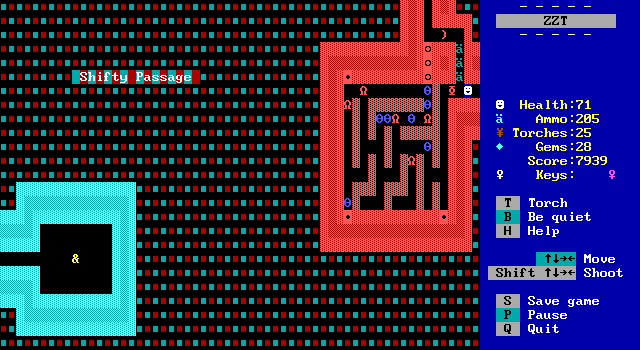
Finally, KKairos gets a double feature board. Like the Maze-O-Matic seen earlier, this board is another example of procedural generation in ZZT. It's presented with a surprising lack of fanfare, there's a scroll citing the maze as a prototype of Z-Labs, a name also used for the owner of the Maze-O-Matic and taken from Zephyr's Z Lab compilation worlds. Rather than making this another mini-game, the maze generated here simply fills out this small corner of the board and remains fixed for the rest of the game. Were it not for the note and the brief flicker as the maze is quickly constructed, you wouldn't be blamed for not even realizing that it was randomly generated. After all, you won't notice unless you play Remix again with the old layout still fresh in your mind.
As such, it's a pretty simple board in terms of how its actually plays. Just as before the maze is populated with a few creatures, though there's no rules on how the player needs to interact with them. The only thing that needs to be done is to press the three buttons in the corners of the room and then head north to actually receive the bank vault combo. A one-way transporter has been included to facilitate making a quick return trip, but with the inclusion of a transporter from the vault combination area to the bank itself, it's going to go unused for the majority of players.
This is one of those boards that gets used in two different contexts. Tim Sweeney's best joke, the ampersand character object named "necklace" that gives you bonus points for finding an ampersand, occupies the other corner of the board. The last second change to accepting the ampersand as a literal one vs a symbol for something is a tough act to follow. Here the object's never revealed name is "AMPERSANDAWARD", in reference to some long past ZZT awards ceremony, with an excited "DUDE! IT'S ONE OF THOSE "&" THINGS!" for the message instead playing off the relative obscurity of what said symbol is actually called. (Is it obscure knowledge these days even?)

